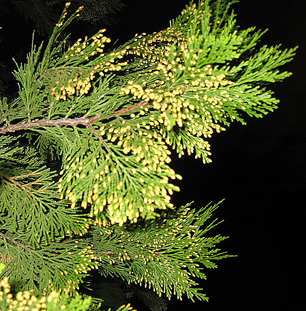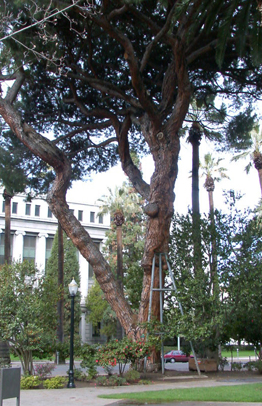Trees--Some of our Favorite Evergreens!
Written for the Davis Enterprise, November 27, 2002
As the leaves of deciduous trees drop and the urban landscape becomes
bare, we begin to appreciate the evergreen trees that give the landscape
distinction and character.
It's no wonder evergreens are traditional
holiday plants! A couple of inches of rain washes the dust off and
suddenly shiny foliage, striking cones, and bright berries provide
glimmers of green vitality on winter days.

These are used differently than our shade trees.
Don't plant them to the
south or west of the house, as winter shade makes the environment cold and
dark. They can be featured for distinctive foliage, planted as windbreaks
or privacy screens, or used to provide cover for songbirds.
When nursery folks say "evergreen" most people think of conifers, the
needle-bearing plants.
Conifers can make great living Christmas trees.
Mostly from rainier climates, the majority prefer frequent summer
irrigation and grow naturally only where annual rainfall is above 30" (we
get 17 - 20" in a normal year). Some are finicky about our water quality
or hot, dry summer climate, while others are very successful. Our
California native conifers and those from similar climates can be great
choices here with careful irrigation.
Many evergreens are broad-leaved; i.e., they have normal leaves, not
needles.
These include bay trees, Acacias and Eucalyptus, California
pepper, Camphor tree, Citrus, laurels, oaks, olives, and sumacs. Many of
these are California natives, or are from the Mediterranean, from
Australia, or climates with similar rainfall and summer heat to ours.
These will be featured in another column.
Some words of caution: people often plant evergreens thinking they are
cleaner
because "they don't drop their leaves." Well, they do...most drop
small amounts of leaves or needles steadily all season. A needle or leaf
of an evergreen lasts three years before dropping. Many (especially
evergreen oaks) have a heavy leaf drop in the spring, while conifers tend
to drop needles with the first summer heat. Also, never prune evergreens
without checking with an expert! Topping ruins most trees and is
especially bad for conifers. The internal hormones of the plant determine
the shape of the tree (they have what botanists call "weak apical
dominance and strong apical control") and removing the growing point can
ruin the tree.
Some of our favorite conifers:
Cedars. Incense cedar (Calocedrus decurrens) is a California native with
shiny green foliage and beautiful red bark. Grows 2' a year as a narrow
column, eventually spreading. Very tolerant of heat, sun, poor soil,
drought.
Deodar and Atlas cedars
(Cedrus deodara and atlantica 'Glauca') are the
dramatic evergreens planted in Stonegate in West Davis. These have
blue-green needles and both make dramatic silhouettes against the winter
sky. The deodar is fast-growing and eventually very large with a slightly
weeping habit. Atlas cedar has an angular growth habit--look at the large
specimen in front of the fire station on Fifth Street (this one lost its
leader years ago, so it has an unusual spreading habit).

Cypresses.
Leylandi cypress
(Cupressocyparis leylandii) is a hybrid that
was planted widely for its fast growth. Still sold at "big box" retailers,
it always gets a canker disease and borers and then dies. Don't plant it.
Arizona cypress
(Cupressus arizonica glabra) is a huge tree for rural
areas--very tolerant of drought and wind.
Italian cypress
(C. sempervirens
'Glauca') is the classic formal column of Italian gardens--sometimes
affectionately called the "graveyard tree." Grows 3' a year; planted 3'
apart, it will provide complete privacy in just a few years.
Pines.
These are tap-rooted trees, so wholesalers must grow them
carefully to avoid circling roots. Trees with kinked or circling roots
will grow fine for many years and then fall over--sometimes slowly,
sometimes suddenly! Italian stone pines and Aleppo pines were widely
planted in the 1970's and 80's. The large Aleppos along Catalina Ave. and
around some of the schools are slowly lying down. They aren't hazardous,
but will eventually have to be replaced. Italian stone pine has an unusually
broad crown and is simply too large for most yards. These sometimes topple
over, which can be disconcerting.
Canary Island pine
(Pinus canariensis) is fast-growing and upright with
long, somewhat drooping needles. The narrow habit makes it very useful,
and it tolerates drought, heat, wind, and lawn watering. The freeze of
1990 caused great distress as we watched all the needles die and drop, but
in the spring there was a burst of new growth and they recovered.
Aleppo
pine
(P. halepensis), properly grown, can be a great, tough tree. There
are good examples north of the Vet Med Teaching Hospital off Hutchison Dr.
Austrian and Japanese black pines and Scotch pines
(P. nigra,
thunbergiana, and sylvestris) are among the best for living Christmas
trees, retaining the classic pyramidal form for many years and tolerating
drought or lawn watering.

Pine nuts come from at least five species.
Singleleaf Pi'on (P.
monophylla) and Pi'on (P. edulis) are from our southwest and desert
mountains. Both grow very slowly and are rare in the trade. Italian stone
pine was mentioned earlier. The Indian longleaf pine from the Himalayas
(P. roxburghii) is uncommon, but is a beautiful tree with lovely drooping
needles--we planted one near the office at Birch Lane Elementary School in
the 1980's. Our native Grey pine (P. sabiniana) has edible seeds and is an
interesting grey-green tree for drought-tolerant landscapes.
Redwoods
(Sequioa sempervirens) are coastal natives; Giant sequoia
(Sequoiadendron, the Big tree of the western Sierra) is an interior
native. Oddly, the interior species doesn't grow here, while the coastal
species is our most widely planted conifer. Giant sequoia is susceptible
to a disease which causes branches to die, so don't plant it.
Coast redwood grows fast--5' a year or more--and keeps an upright, narrow
habit.
It can be grown as a hedge (see the planting near the Hort Dept.
along Old Davis Rd.), or planted in groups of 2 - 3 to screen a neighbor's
roof line, but remember--they eventually get very, very tall! This is one
of the rare conifers that you may prune, as they have growth buds that
resprout even when the tree is chopped down. Pruning the tips of side
branches will induce greater density, and the lower branches can be
removed as the tree grows to expose the beautiful bark.

Coast redwood is never drought-tolerant, preferring deep weekly watering
even when mature.
Heavy needle drop and brown needle tips in the summer
are exacerbated by drought. Seed-grown trees are highly variable in color
and density, and some are downright ugly, so most growers start cuttings
of selected varieties: 'Soquel' (dark green, dense) and 'Aptos Blue' (dark
bluish-green, more open) are two of the best clones. Some varieties with
silvery-blue foliage are also available.
Evergreens provide the "backbone" in the landscape, with clean,
good-looking foliage year-'round that provides a backdrop for flowers,
berries, and fall colors of other plants.
For a table of information about evergreens, conifers and broad-leaved, click here.
© 2008 Don Shor, Redwood Barn Nursery, Inc., 1607 Fifth Street, Davis, Ca 95616
www.redwoodbarn.com
Feel free to copy and distribute this article with attribution to this author.
Click here for Don's other Davis Enterprise articles
